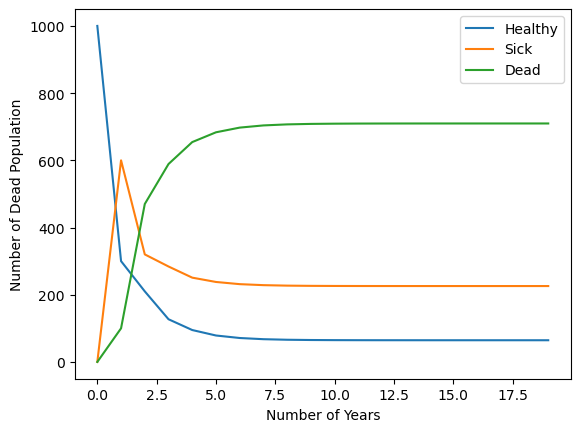Numerical Calculations of Eigenvalues/Eigenvectors in python
Contents
Numerical Calculations of Eigenvalues/Eigenvectors in python#
Unsurprisingly, there is a function to calculate eigenvalues and eigenvectors in python!
For most cases, we can use the
np.linalg.eigfunctionIf we only wanted the eigenvalues,
np.linalg.eigvalswill just calculate those.
Example 1: real roots#
Let’s start with a simple example where we already know the roots: a lower triangular matrix
import numpy as np
A = np.array([[6,10,6],
[0,8,12],
[0,0,2]])
# Fill this in!
eigvals, eigvecs = np.linalg.eig(A)
# Notice that we can use variables in a print!
# f'something {var}' means sub in the var in the string
print(f'Eigenvalues = {eigvals}')
print(f'Eigenvectors: \n{eigvecs}')
Eigenvalues = [6. 8. 2.]
Eigenvectors:
[[ 1. 0.98058068 0.84270097]
[ 0. 0.19611614 -0.48154341]
[ 0. 0. 0.24077171]]
Let’s compare these to the known values from lecture 6:
Eigenspace corresponding to \(\arr{A}\) : \begin{array}{} 6, \begin{bmatrix} 1\0\0 \end{bmatrix} ; & 8,\begin{bmatrix} 5\1\0 \end{bmatrix}; & 2, \begin{bmatrix} 7-4\2\end{bmatrix} ; & \vec{x}=\vec{0} \end{array}
Notice that the eigenvectors returned by numpy are the same ratios, but different absolute numbers. We can rescale these if we need.
eigvecs[:,1]/eigvecs[0,1]*5
array([5., 1., 0.])
eigvecs[0,1]/eigvecs[1,1]
4.999999999999999
eigvecs[:,2]/eigvecs[2,2]*2
array([ 7., -4., 2.])
Complex roots#
\( \arr{A} = \begin{bmatrix} 1&2 \\ -2&1 \end{bmatrix} \)
This is easy now that we know how to use np.linalg.eig!
A = np.array([[1,2],
[-2,1]])
eigvals, eigvecs = np.linalg.eig(A)
print(f'Eigenvalues = {eigvals}')
print(f'Eigenvectors: \n{eigvecs}')
Eigenvalues = [1.+2.j 1.-2.j]
Eigenvectors:
[[0. -0.70710678j 0. +0.70710678j]
[0.70710678+0.j 0.70710678-0.j ]]
eigvals[0]+1.j
(1+3.0000000000000004j)
Notice that numpy is using “j” to indicate a complex number. Otherwise things look pretty simple!
Here are some examples of complex numbers:#
a = 1+2.j
print('a=%s'%str(a))
print('a+1=%s'%str(a+1))
print('2a=%s'%str(2*a))
a=(1+2j)
a+1=(2+2j)
2a=(2+4j)
In-class problem#
Calculate the eigenvalues and eigenvectors for the matrix
\(\arr{A} = \begin{bmatrix} 0&9&-12 \\ -9&0&20 \\ 12&-20&0 \end{bmatrix}\)
import numpy as np
A = np.array([[0,9,-12],
[-9,0,20],
[12,-20,0]])
eigvals, eigvecs = np.linalg.eig(A)
print(eigvals)
print(eigvecs)
[3.19744231e-16 +0.j 0.00000000e+00+25.j 0.00000000e+00-25.j]
[[ 0.8 +0.j 0.21828206-0.36380344j 0.21828206+0.36380344j]
[ 0.48 +0.j 0.13096924+0.60633906j 0.13096924-0.60633906j]
[ 0.36 +0.j -0.6596969 +0.j -0.6596969 -0.j ]]
Population eigenvalue problem#
Let’s start with calculating the eigenvalues and eigenvectors of the population transition matrix \(\arr{A}\)
A = np.array([[0.3,0.2,0],
[0.6,0.2,0],
[.1,0.6,1]])
eigvals, eigvecs = np.linalg.eig(A)
print(f'Eigenvalues = {eigvals}')
print(f'Eigenvectors: \n{eigvecs}')
Eigenvalues = [ 1. -0.1 0.6]
Eigenvectors:
[[ 0. 0.40824829 -0.32444284]
[ 0. -0.81649658 -0.48666426]
[ 1. 0.40824829 0.81110711]]
Matches up with what we already know!
Let’s do a little example for a random starting population of 1000 people. We can use a tool like np.random.rand to generate random numbers.
# make a vector p for the starting population
# 3 random numbers from 0-1 that up to 1
np.random.seed(42)
p = np.random.rand(3)
p = p/p.sum()
# multiply each fraction by 1000 people
p = p*1000
# Make sure there's an integer number of people
p = p.round()
print('The starting population is %d healthy, %d sick, %d dead'%(p[0],p[1],p[2]))
The starting population is 182 healthy, 462 sick, 356 dead
Now, let’s increment the population:
p2 = A@p
print('The population after one year is %d healthy, %d sick, %d dead'%(p2[0],p2[1],p2[2]))
The population after one year is 147 healthy, 201 sick, 651 dead
n_years = 200
p2 = np.linalg.matrix_power(A,n_years)@p
print('The population after %d year is %1.3f healthy, %1.3f sick, %1.3f dead'%(n_years, p2[0],p2[1],p2[2]))
The population after 200 year is 0.000 healthy, 0.000 sick, 1000.000 dead
Let’s do this after n iterations:
def population(init_pop, n_years):
return np.linalg.matrix_power(A,n_years)@init_pop
population(p,3)
array([ 51.03 , 76.356, 872.614])
Now, let’s go ahead and see what happens if we solve it as an eigenvalue problem!
c_vector = np.linalg.solve(eigvecs, p)
print(c_vector)
p_infinite = c_vector[0]*eigvecs[:,0]
print('The final population after infinite years is %d healthy, %d sick, %d dead'%(p_infinite[0],
p_infinite[1],
p_infinite[2]))
[1000. -132.27244611 -727.40085235]
The final population after infinite years is 0 healthy, 0 sick, 1000 dead
Notice that everyone dies. This happens for any starting configuration.
In-class problem: zombies#
We discover that there’s a 20% chance of a dead person coming back from the dead as a sick person (a zombie?).
Make a function zombie_population(init_pop, n_years) that calculates the population given a starting population
Calculate the steady state distribution of live, sick, and dead people.
What questions do we have?
A = np.array([[0.3,0.2,0],
[0.6,0.2,0.2],
[.1,0.6,0.8]])
eigvals, eigvecs = np.linalg.eig(A)
print(eigvals)
print(eigvecs)
[-0.17015621 0.47015621 1. ]
[[ 0.34604809 -0.44068607 0.08630637]
[-0.81348329 -0.37492736 0.3020723 ]
[ 0.4674352 0.81561343 0.94937007]]
zombie_A = np.array([[0.3,0.2,0],
[0.6,0.2,0.2],
[.1,0.6,0.8]])
def zombie_population(init_pop, n_years):
return np.linalg.matrix_power(zombie_A,n_years)@init_pop
zombie_population([800,200,0],100)
array([ 64.51612903, 225.80645161, 709.67741935])
init_pop = [1000,0,0]
num_healthy = [zombie_population(init_pop,n_years)[0] for n_years in range(0,20)]
num_sick = [zombie_population(init_pop,n_years)[1] for n_years in range(0,20)]
num_dead = [zombie_population(init_pop,n_years)[2] for n_years in range(0,20)]
import matplotlib.pyplot as plt
plt.plot(range(0,20),num_healthy,label='Healthy')
plt.plot(range(0,20),num_sick, label='Sick')
plt.plot(range(0,20),num_dead, label='Dead')
plt.legend()
plt.xlabel('Number of Years')
plt.ylabel('Number of Dead Population')
Text(0, 0.5, 'Number of Dead Population')

zombie_A = np.array([[0.3,0.2,0],
[0.6,0.2,0.2],
[.1,0.6,0.8]])
def zombie_population(init_pop, n_years):
return np.linalg.matrix_power(zombie_A,n_years)@init_pop
zombie_population(p, 400)
array([ 64.51612903, 225.80645161, 709.67741935])

